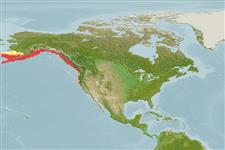>
Osmeriformes (Freshwater smelts) >
Osmeridae (Smelts)
Etymology: Thaleichthys: Greek, thaleia, -as = abundance + Greek, ichthys = fish (Ref. 45335); pacificus: pacificus - of the Pacific (Ref. 1998).
More on author: Richardson.
Environment: milieu / climate zone / depth range / distribution range
Ekologi
laut; air tawar; payau; anadromus (ruaya dari laut ke air tawar) (Ref. 51243); kisaran kedalaman 0 - 300 m (Ref. 6793). Temperate; 61°N - 40°N, 171°W - 121°W (Ref. 86798)
North Pacific: west of Saint Matthew Island and Kuskokwim Bay in the Bering Sea, and Bowers Bank in the Aleutian Islands to Monterey Bay, California, USA. Populations from northern British Columbia are separate from those in the Fraser River (Ref. 10276).
Length at first maturity / Size / Weight / umur
Maturity: Lm 15.5, range 15 - 16 cm
Max length : 34.0 cm TL jantan/; (Ref. 56527); common length : 20.0 cm TL jantan/; (Ref. 7354); Umur maksimum dilaporkan: 5 Tahun (Ref. 12193)
Duri punggung (Keseluruhan (total)): 0; duri punggung lunak (Keseluruhan (total)): 10-13; Duri dubur 0; Sirip dubur lunak: 18 - 23; vertebrata, bertulang belakang: 65 - 72. Distinguished by the large canine teeth on the vomer and 18 to 23 rays in the anal fin (Ref. 27547). Adipose fin sickle-shaped; paired fins longer in males than in females; all fins with well developed breeding tubercles in ripe males which are poorly developed or absent in females (Ref. 27547). Adult coloration is brown to blue on back and top of the head, the sides lighter to silvery white, and the ventral surface white; speckling is fine, sparse and restricted to the back; peritoneum is light with black speckles (Ref. 6885). Fins transparent, pectorals and caudal often dusky (Ref. 27547). During spawning, male fish has a distinctly raised ridge along the middle of the body and a rough texture, differentiating it from the female which is smaller, smoother and shinier.
Found near shore and in coastal inlets and rivers (Ref. 2850). Possibly to 625 m depth (Ref. 6793). Spends most of its life in the sea, returning to freshwater streams to spawn (Ref. 27547). There is evidence of return to natal streams (Ref. 10276). May migrate up to 160 km upstream. Feeds on plankton and only while at sea (11699, 10276). Excellent food fish and source of oil (15% body wt.). Anadromous (Ref. 96339).
The spawning run from the sea to freshwater streams begins when river temperature rises to about 4.4° but the fish stop running if temperature exceeds 7.8°C. Males predominate the early part of the run, but their numbers are equalled or exceeded by females later (Ref. 10276, 11699). Adults usually die after spawning but some move back to the sea and return to spawn a second time (Ref. 1998). Upon hatching, larvae are found near the bottom and are soon carried downstream to salt water and eventually found in the scattering layer of coastal waters (Ref. 27547).
Eschmeyer, W.N., E.S. Herald and H. Hammann, 1983. A field guide to Pacific coast fishes of North America. Boston (MA, USA): Houghton Mifflin Company. xii+336 p. (Ref. 2850)
Status IUCN Red List (Ref. 130435)
ancaman kepada manusia
Harmless
penggunaan manusia
Perikanan: komersial
informasi lanjut
mitraGambarStamps, Coins Misc.Suara-suaraCiguateraKecepatanTipe renangArea insangOtolithsOtakPenglihatan / visi
Alat, peralatan
laporan khas
muat turun XML
Sumber internet
Estimates based on models
Preferred temperature (Ref.
123201): 1.3 - 8.6, mean 4.2 °C (based on 403 cells).
Phylogenetic diversity index (Ref.
82804): PD
50 = 1.0000 [Uniqueness, from 0.5 = low to 2.0 = high].
Bayesian length-weight: a=0.00372 (0.00182 - 0.00758), b=3.17 (2.99 - 3.35), in cm total length, based on LWR estimates for this (Sub)family-body shape (Ref.
93245).
Trophic level (Ref.
69278): 3.3 ±0.37 se; based on food items.
Generation time: 3.2 ( na - na) years. Estimated as median ln(3)/K based on 1
growth studies.
Daya lenting (Ref.
120179): sedang, Waktu penggandaan populasi minimum 1.4 - 4.4 tahun (tm=2-6; tmax=5; K=0.34; Fec=17,000-60,000 Musick et al. 2000 (Ref.
36717)).
Fishing Vulnerability (Ref.
59153): Low to moderate vulnerability (33 of 100).
Climate Vulnerability (Ref.
125649): Moderate vulnerability (35 of 100).
Nutrients (Ref.
124155): Calcium = 98.1 [24.8, 242.3] mg/100g; Iron = 0.808 [0.238, 2.305] mg/100g; Protein = 14.8 [13.7, 16.1] %; Omega3 = 1.23 [0.53, 3.04] g/100g; Selenium = 13.3 [5.8, 38.0] μg/100g; VitaminA = 15.1 [4.9, 47.7] μg/100g; Zinc = 1.02 [0.47, 1.97] mg/100g (wet weight); based on
nutrient studies.
